“Quince Orchard” by the sea Population: 37,000
Market day: Thursday (central Ayvalık), Sunday (Ayvalık covered market)
Travellers in a hurry could easily rush through Ayvalık without realising what makes it so wonderful. The high street looks like Anywhereville Turkey and it’s only when you plunge into the side streets that the town’s charm starts to reveal itself in the shape of street upon street of Ottoman-era stone houses, many of them now restored to serve as modern homes or boutique pensions.
A string of small sandy beaches lie south of Ayvalık around Sarımsaklı and Şeytan Sofrası. There are more on what was Alibey Adası (island) and is now Cunda which is attached to Ayvalık by a causeway, making it accessible all year round.
Backstory
The houses and five churches bear silent witness to the trauma of the 1924 population exhange when, in the period following the Turkish War of Independence, all the Greeks living in Turkey were forced to “return” to Greece while the Turks living in Greece were forced to “return” to Turkey.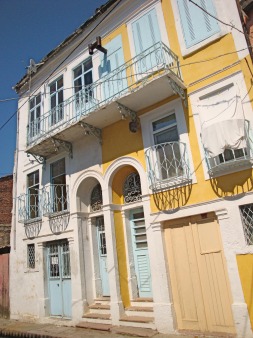
Although there had always been large Greek populations in most of the coastal settlements it was a freak chance that led the Greek residents of Ayvalık to rescue the captain of the Ottoman navy, Cezayirli Hasan Paşa (1714-90), after his fleet was defeated at the Battle of Çeşme by the Russians in 1770. A slave who eventually rose to become Grand Vizier to Sultan Selim III, Hasan Paşa never forgot the town that had helped him, granting it virtual autonomy in 1773. As a result 19th-century Ayvalık became second only to İzmir in importance as an Aegean port.
From then on it became an entirely Greek settlement, a status it shared only with Tatavla (now Kurtuluş) in Istanbul, which meant that the impact of the population exchange was especially drastic. The Turks who arrived in Ayvalık were mainly from nearby Lesbos (Midilli) and more distant Crete (Griti); the Cretans mainly settled on Cunda, the Lesbians in Ayvalık itself. Still today there are a few local residents who speak Greek and restaurant names often commemorate the owners’ ancestral homes.
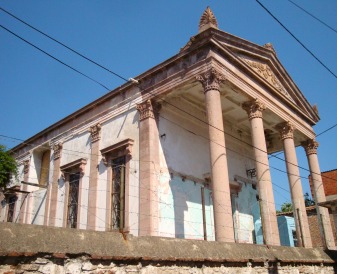 Around town
Around town
Ayvalık’s most obvious attraction is the fishing harbour that ensures that this is a town with a life beyond tourism. Colourful boats bob up and down beside a lengthy promenade. Some are piled high with fishing nets, others tout tours to Cunda Island, just across the bay, or to the nearby islands. In summer there are often tours to lovely Assos/Behramkale, a short cruise away to the north.
Beyond the high street a few soaring brick chimneys stand as reminders of the days when town-centre factories churned out olive oil by the vat-load. Nowadays the work has moved into modern factories on the outskirts, and a branch of Tansaş has taken up residence in one of the abandoned premises. Attractive modern shops now sell olive oil in the sort of packaging that facilitates premium pricing.
Now one of the town’s finest new hotels, the Sızma Han Hotel hunkers down in a converted factory right on the waterfront with great views out towards Cunda (Alibey Adası).
East of the main road the streets preserve a townscape of stone-built Ottoman houses virtually intact. These are solid houses, all of them slightly different in the decorative details of their doors and windows; the blush-pink trims were carved out of Sarımsaklı stone, a volcanic material quarried nearby. 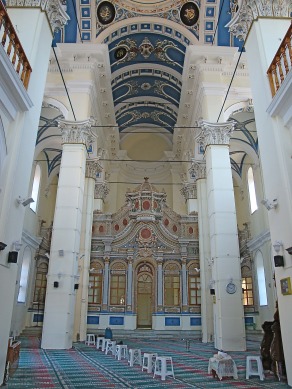
The Greeks endowed their town with some truly magnificent churches, the most conspicuous being the Ayios Yannis Kilise that was converted into the Saatli Cami (Mosque with a Clock) in 1923.
Imposing as it is, Ayos Yannis is not a patch on nearby Ayios Yorgis (Çınarlı Cami), which still retains the soaring stone iconostasis that used to separate the nave from the chancel, albeit with its icons long since removed.
The Taksiyarhis Kilise (Church of the Archangels), built in 1844 and never turned into a mosque, is being restored to serve as a home for a new Koç museum, but the prettiest of the abandoned churches is the Faneromani Kilise (AKA Ayazma Kilise), a mini-Parthenon built in pink-toned Sarımsaklı stone in 1890 but fenced off for a restoration that seems to have ground to a halt.
The much more austere Kato Panaya Kilise found new life as the Hayrettinpaşa Cami, while the poor Aya Triada Kilise (Holy Trinity Church) is a burnt-out shell coated in graffiti.
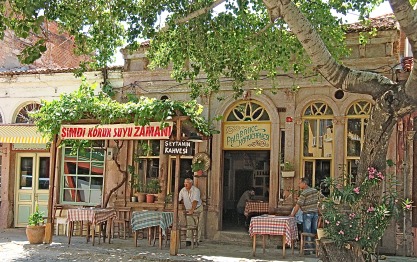 The Greek heritage of Ayvalık also makes itself felt in the wonderfully atmospheric Palabahçe Kahvehanesi, also named rather alarmingly as Şeytanın Kahvesi (“the Devil’s Coffeehouse”) after the current owner’s grandfather. The café starred in the television series İki Yaka Bir İsmail (Two Continents, One İsmail), the story of a philanderer who keeps two women in two different ports, one Turkish and one Greek.
The Greek heritage of Ayvalık also makes itself felt in the wonderfully atmospheric Palabahçe Kahvehanesi, also named rather alarmingly as Şeytanın Kahvesi (“the Devil’s Coffeehouse”) after the current owner’s grandfather. The café starred in the television series İki Yaka Bir İsmail (Two Continents, One İsmail), the story of a philanderer who keeps two women in two different ports, one Turkish and one Greek.
West of the high street the sturdy waterfront warehouses in the rather gloomy back streets are finding new life as cafes and bars.
 Around Ayvalık
Around Ayvalık
Ayvalık straggles its way along the coast, and there’s a pleasant seaside walk to adjoining Çamlık which bypasses some of the magnificent mansions left over from the town’s 18th and 19th-century heyday.
Eating
The fish restaurants may look mouth-watering but their prices are pretty eye-watering too. Luckily there are plenty of alternatives.
There is, for example, a grapevine-shaded part of the main shopping center just off Talatpaşa Caddesi where locals pour in to tuck into köfte (meatballs) at lunchtime, while Tenekeciler Sokağı, a narrow passage on the inland side of the main road through town, is packed with small meyhanes where, in season, you can try eating sea urchins (denizkestanesi).
Finally, if you need to watch the lira, you should head for the Tansaş supermarket. Right next door there’s a whole Tostcular Çarşı (Toast-makers Market) full of small cafes serving Ayvalık Tostu, a toasted sandwich so full of salami, pickles, tomatoes and pepper and coated with such a thick helping of ketchup and mayonnaise that you’ll have trouble getting your mouth round it.
Sleeping
The best way to appreciate the beauty of the old houses is to check into one of the many delightful small pensions in the back streets. Space is usually at a premium which means shared facilities in a few cases.
Zeytin Pension Tel: 0266-312 1004
Bonjour Pansiyon. Tel: 0266-312 8085
Annette’s House. Tel: 0266-312 5971
Yalı Pansiyon. Tel: 0266-312 242
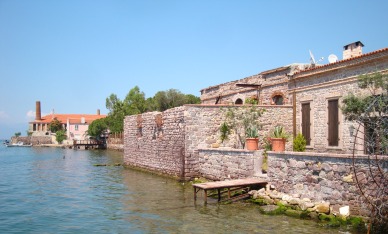 Travel info
Travel info
In summer there are a few Pegasus flights to Edremit. Otherwise it’s a long drive or bus ride from İstanbul. There are also regular buses to Ayvalık from İzmir, and more limited services from Bergama (60km).
For the time being (2012) Ayvalık has no real bus station so you will be dropped off and picked up at the service stations at Ekbir (to the north) and Akkuşlar (to the south).
To get to Cunda there are old-fashioned dolmuş-taxis services; hourly ferries also leave from the Ayvalık waterfront during the school summer break.
In summer there are daily (except Sunday) ferry services to Lesbos, timed to make a day trip possible. Book ahead and bring your passport. In winter services drop to two or three sailings a week. Jale Lines (Tel: 0266-331 3170) takes care of bookings.
Day trip destinations
Lesbos (Midilli)



